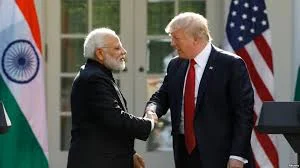Intriguingly, European Central Bank Chief Christine Lagarde, in her first interview since Donald Trump won his second term to enter the Oval Office as the 47th President of the US, advised Europe’s political leaders “not to retaliate, but to negotiate” with the President-elect who asserted that he would impose tariffs between 10% to 20% on all non-Chinese imports into his country.
She also warned that a “trade war at large” is “in nobody’s interest” for it would lead to “a global reduction of GDP”. Indeed deviating from her earlier stance, Lagarde advised European leaders to navigate through Trump’s second term by adopting a “cheque-book strategy”, they may “buy certain things from the US” such as liquefied natural gas, defense equipment, etc. For, it would signal a willingness to cooperate with the US, which in turn could aid both sides to de-escalate the conflict further.
This advice given by Lagarde to EU nations perhaps merits consideration by India, for the country’s economy too is unlikely to remain unaffected by Trump’s vow to hike tariffs. Although many opine that for now India has been spared, one cannot afford to ignore what Trump said during his first term: “India has high tariffs”, citing its 100% tariff on Harley-Davidson motorcycles and 150% on American whisky, even labeled India the “tariff king”.
So, it wouldn’t be surprising if Trump this time round pressurizes India for reduction in tariffs on American goods, particularly on agricultural produce, dairy, and animal products, despite the fact they are well within the WTO norms. Indeed, he aired similar comments in his recent press meet in Florida. Besides, US being the top trading partner with more than $190 bn in trade, and 80% of IT sector exports relying on US, India cannot afford to ignore these probabilities.
That aside, as the BCG India Chairman Janmejaya Sinha observed, it is no guarantee that the pain, if any, inflicted by the proposed tariffs by Trump on China will automatically leads to a gain for India. For, to compete with China in production what a country needs to offer to the global corporates’ investment is not merely the reduction in cost but stability—stability in policy framework, the persistence of which China continues to offer till date, in many ways.
Another big challenge is scale. Even though large industrial houses have of late started investing heavily in sectors such as electronics and semiconductors duly supported by the government scheme to offer tens of billions of dollars in the form of production-linked incentives, it is no match for what China did. There is a fear that unlike in China, there is a great problem relating to not only scale but also procurement of raw materials in India.
Over and above all this, to realize the ambition of India becoming the electronics manufacturing hub, the country has to penetrate deeper into the supply chain by increasing the domestic value addition from the current 18%-20% to 40% in the immediate future. In view of all these hurdles, one wonders if the proposed hike in tariffs on Chinese goods by the Trump regime may not necessarily divert massive investments away from China. In fact, there are already reports indicating that US companies have put a pause on making further investments in India. Analysts even say that today from an investing perspective, America has zero interest in international markets.
Speaking at the Global Economic Policy Forum 2024, World Bank Chief Economist Indermit Gill made two very important observations which demand India’s attention: one, global economic growth has been decelerating, with the potential growth rate in advanced economies halving over the past two decades; and two, even emerging markets and developing economies are seeing a decline in potential growth rates due to ongoing geopolitical tensions, trade fragmentation, policy uncertainty, and persistent inflation. Further, observing that the “changes needed are not happening quickly enough” in India, he urged policymakers to leverage the economy’s strength by accelerating structural reforms.
Amidst all these hurdles coupled with consistently high inflation for the past two years, if India has to pursue its Viksit Bharat objective, it must continue to grow at least above 7-8% annually. Here, it is pertinent to remember that India ranks 153 against South Korea’s 44 and Taiwan’s 35 in the per capita export data generated by the World Bank and UNCTAD for about 200 countries. Even in service exports, India ranks 89 out of 114 countries trailing behind Malaysia, Turkey, Thailand, etc. Secondly, according to best-selling authors Gary W Keller and Jay Papasan, the one thing that could drive economic success is climbing the global value chain and thereby accomplishing sustained double-digit export performance. And, if this has to happen, we may have to follow the advice given by Lagarde: Adopt a cheque-book strategy while navigating through the Trump era and strengthen the ties with the US by leveraging on the friendly chord already struck as a participant of QUAD dialogue.
**

No comments:
Post a Comment